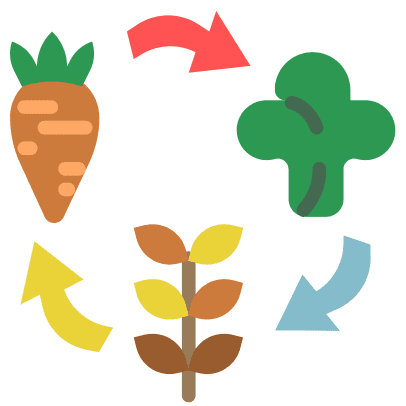As the vibrant hues of summer fade and a cool breeze begins to hint at the changing season, we as gardeners and plant enthusiasts eagerly anticipate the arrival of fall. While many may associate spring with planting, autumn presents a fantastic opportunity to continue cultivating your green space and enjoying a bountiful harvest.

Let’s be honest, transitioning to a fall garden after all the work we’ve put in during the summer can be hard. Sometimes it’s nice to pack up the garden, so to speak, and work on something different. Also, in the higher zones, fall is often hotter or just as hot as summer, which prevents planting straight away after the school year begins. Nevertheless, fall vegetable planting, whenever that happens in your area, opens up a world of possibilities, allowing us to savor fresh produce even as the days grow shorter. What we plant in the fall is so different from what was growing during the summer, and our waning strength is often galvanized by that. In this blog, we’ll explore the joys and benefits of fall vegetable planting and provide you with some essential tips to make the most of this season.
Embrace the Bounty (and Beauty) of Autumn
Fall vegetable planting is more than just an extension of your gardening efforts; it’s a chance to embrace the unique beauty of the season. As leaves turn into brilliant shades of red, orange, and gold, your garden can become a canvas of both color and flavor.
Imagine strolling through a garden dotted with leafy kale, vibrant Swiss chard, and hearty Brussels sprouts against the backdrop of falling leaves. It’s a picturesque scene that blends the aesthetic appeal of autumn with the rewards of homegrown produce.

Advantages of Fall Vegetable Planting
- Cooler Temperatures: Fall’s cooler temperatures provide a more favorable environment for certain vegetables. Plants that struggle in the summer heat can thrive during the milder days of autumn.
- Less Pests and Disease: Many common garden pests and diseases tend to diminish as summer ends. This reduces the likelihood of your crops being compromised and often leads to healthier plants.
- Extended Harvest: By planning your fall garden carefully, you can enjoy a prolonged harvest season. Some crops even develop sweeter flavors as they experience cooler temperatures.
- Less Watering: Fall tends to bring more rain, reducing the need for excessive watering. This is not only environmentally friendly but also helps streamline your gardening routine.
- A Good Time to Grow Cover Crops: Crops like kale, radishes, turnips, and other broad-leaf greens are ideal for use as cover crops and food sources during the winter. Clover, ryegrass, legumes, and peas are also good cover crops for winter.

A Chance to Practice Crop Rotation: Some plants contribute to soil health. For example, peas and nasturtiums add nitrogen to soil. By planting these in the fall, your soil is then ready for nitrogen-taking crops like corn the next summer.
Top Picks for Fall Planting
Broccoli: This cool-weather favorite develops tender florets during fall’s mild temperatures. If you are not a fan of broccoli, we urge you to try growing it yourself. As we experience with most home-grown food, it is more tender and more flavorful than any mass produced, store bought broccoli out there.
Carrots: Cooler weather enhances the sweetness of carrots, making them a delightful addition to fall dishes. Nothing beats baked/broiled home-grown carrots with a bit of olive oil and sea salt. So sweet, so tender, you will eat them right off the sheet!
Kale: A nutritional powerhouse, kale becomes even more robust and flavorful in cooler climates. Add kale to your fall and winter soups, or toss it with olive oil and salt and bake for a crunchy, super healthy snack.
Lettuce & Arugula: With a variety of types available, lettuce is perfect for fall salads and sandwiches. You may not be in the mood for a cold salad on a cold day, but consider adding fresh leaves to a grilled panini.
Spinach: Its cold tolerance makes spinach an excellent candidate for fall planting. The perfect addition to fall soups!
Radishes: These quick-growing root vegetables are ready to harvest in just a few weeks, making them a convenient choice for fall gardening. We have always loved how satisfying growing radishes is – days to maturity is under a month.
Tips for Successful Fall Gardening
Know Your First Frost Date: Research the average date of the first frost in your region. This information is crucial for planning when to plant and which crops to choose.
Choose Shorter Days to Maturity: Opt for vegetable varieties with shorter days to maturity to ensure they can reach full growth before frost arrives.
Prepare the Soil: Clear your garden beds of summer debris, amend the soil with compost, and ensure proper drainage for healthy root development.
Provide Protection: Be prepared to cover your crops with frost cloths or row covers if a surprise frost threatens.
Water Wisely: While fall often brings more rain, keep an eye on the moisture levels in your garden. Water deeply when needed, especially for newly planted crops.
Consider Containers: If you lack garden space, many fall vegetables can thrive in containers placed on sunny patios or balconies.

Plan to Savor!
Fall vegetable planting presents an exciting opportunity to extend your gardening season, embrace the beauty of autumn, and enjoy a harvest of fresh, flavorful produce. With careful planning, the right selection of vegetables, and attention to the unique needs of fall gardening, you can make the most of this season’s offerings. But let’s face it – this does require continued work, as so many endeavors of worth do. So, roll up your sleeves, prepare your garden beds, and let the magic of fall vegetable planting unfold before you. Your efforts will be rewarded with both the satisfaction of successful cultivation and the joy of savoring the fruits of your labor as the leaves continue to fall.